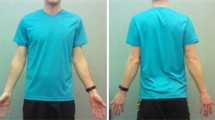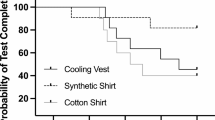Abstract
The aim of this study was to investigate the impact of six cycling garments constituted of different materials, during a constant moderate cycling exercise in a hot and moist environment on (a) thermal sensation, (b) change of thermoregulatory parameters, and (c) sweat absorption. Ten cyclists from an amateur to a professional level (age: 21 ± 4.6 years, height: 180.1 ± 6.7 cm; body mass: 70.9 ± 7.8 kg, body mass index: 21.8 ± 1.6) performed six-twenty min pedaling sessions at 4 on CR 10 Borg scale in a hot and moist environment (environmental temperature = 32.8 ± 0.9 °C and relative humidity = 63.4 ± 8.5%), wearing six garments composed of different materials. Heart rate, power output, and core temperature were measured continuously. Skin temperature in 16 regions of interest was measured with an infrared camera every 5 min. The rating of perceived exertion and the thermal sensations was measured every two min. The sweat absorbed by the garment during the exercise was also quantified. The absence of differences concerning power output, heart rate, core temperature, and the mean skin temperature between garments suggested that non-physiological parameters could also explain the significant differences of mean thermal sensations observed between garments (p < 0.05). Indeed, the quantity of sweat absorbed by garment was significantly positively correlated to mean thermal sensations during the exercise (p < 0.05), suggesting that a bad sweat evacuation by the garment involves an increase of thermal sensations. Moreover, the significant relation predicting mean thermal sensations with the quantity of sweat absorbed, the evolution of the skin temperature in the low back, and in the abdomen regions between 0 and 20 min indicated that local heat exchanges by garment would impact thermal sensation.





Similar content being viewed by others
Abbreviations
- ES:
-
Effet size
- HR:
-
Heart rate
- PO:
-
Power output
- RH:
-
Relative humidity
- RPE:
-
Rate of perceived exertion
- R-SJM:
-
Race short + jersey for mild conditions
- R-SJS:
-
Race short + jersey for summer condition
- R-SM:
-
Race suit for mild conditions
- R-SS:
-
Race suit for summer conditions
- SL:
-
Sweat loss
- SA:
-
Sweat absorption
- T c :
-
Core temperature
- T e :
-
Environmental temperature
- TT-SM:
-
Time-trial suit for mild conditions
- TT-SS:
-
Time-trial suit for summer conditions
- TS:
-
Thermal sensation
- TSk:
-
Skin temperature
- TSk(ROIs) :
-
Skin temperature at region of interest
- TSk(mean) :
-
Mean skin temperature
References:
Gerrett N, Kingma BRM, Sluijter R, Daanen HAM (2019) Ambient conditions prior to tokyo 2020 olympic and paralympic games: considerations for acclimation or acclimatization strategies. Front Physiol 10:414
Sawka MN, Leon LR, Montain SJ, Sonna LA (2011) Integrated physiological mechanisms of exercise performance, adaptation, and maladaptation to heat stress. Compr Physiol 1:1883–1928
Tucker R, Rauch L, Harley YX, Noakes TD (2004) Impaired exercise performance in the heat is associated with an anticipatory reduction in skeletal muscle recruitment. Eur J Appl Physiol 448:422–430
Van Cutsem J, Roelands B, De Pauw K et al (2019) Subjective thermal strain impairs endurance performance in a temperate environment. Physiol Behav 202:36–44. https://doi.org/10.1016/j.physbeh.2019.01.011
Gonzales BR, Hagin V, Guillot R et al (2011) Effects of polyester jerseys on psycho-physiological responses during exercise in a hot and moist environment. J Strength Cond Res 25:3432–3438
Millet G, Perrey S, Divert C, Foissac M (2006) The role of engineering in fatigue reduction during human locomotion—a review. Sports Eng 9:209–220. https://doi.org/10.1007/BF02866059
Pascoe DD, Bellingar TA, McCluskey BS (1994) Clothing and exercise. II. Influence of clothing during exercise/work in environmental extremes. Sports Med 18:94–108
Smith CJ, Havenith G (2011) Sweat mapping in humans and applications for clothing design. In: The Fourth International Conference on Human-Environment System, Sapporo, Japan, pp 3–6
Schulze E, Daanen HA, Levels K et al (2015) Effect of thermal state and thermal comfort on cycling performance in the heat. Int J Sports Physiol Perform 10:655–663
Abreu MJ, Catarino A, Tama D (2018) Evaluating the effect of fabric type on thermal insulation properties of sports clothing. In: IOP conference series: materials science and engineering. p 012005
Clark RP, Mullan BJ, Pugh LG (1977) Skin temperature during running-a study using infra-red colour thermography. J Physiol 267:53–62
de Fernandes AA, dos Santos Amorim PR, Brito CJ et al (2016) Regional skin temperature response to moderate aerobic exercise measured by infrared thermography. Asian J Sports Med. https://doi.org/10.5812/asjsm.29243
Tanda G (2015) The use of infrared thermography to detect the skin temperature response to physical activity. J Phys Conf Ser 655:12–62
Torii M, Yamasaki M, Sasaki T, Nakayama H (1992) Fall in skin temperature of exercising man. Br J Sports Med 26:29–32
Nakayama T, Ohnuki Y, Kanosue K (1981) Fall in skin temperature during exercise observed by thermography. Jpn J Physiol 31:757–762
Havenith G, Fogarty A, Bartlett R et al (2008) Male and female upper body sweat distribution during running measured with technical absorbents. Eur J Appl Physiol 104:245–255
Quesada JIP, Carpes FP, Bini RR et al (2015) Relationship between skin temperature and muscle activation during incremental cycle exercise. J Therm Biol 48:28–35
Taylor NAS (2000) Principles and practices of heat adaptation. J Hum Environ Syst 4:11–22
Arens EA, Zhang H (2006) The skin’s role in human thermoregulation and comfort. In: Thermal and mositure transport in fibrous materials, pp 560–597
Brazaitis M, Kamandulis S, Skurvydas A, Daniusevičiūtė L (2010) The effect of two kinds of T-shirts on physiological and psychological thermal responses during exercise and recovery. Appl Ergon 42:46–51
Leoz-Abaurrea I, Aguado-Jiménez R (2017) Upper body compression garment: physiological effects while cycling in a hot environment. Wilderness Environ Med 28:94–100
Aldemir H, Atkinson G, Cable T et al (2000) A comparison of the immediate effects of moderate exercise in the early morning and late afternoon on core temperature and cutaneous thermoregulatory mechanisms. Chronobiol Int 17:197–207. https://doi.org/10.1081/CBI-100101043
Costa CMA, Sillero-Quintana M, Piñonosa Cano S et al (2016) Daily oscillations of skin temperature in military personnel using thermography. J R Army Med Corps 162:335–342. https://doi.org/10.1136/jramc-2015-000462
Borg G (1998). Borg’s perceived exertion and pain scales. In: Human kinetics, pp 13–16
Moreira DG, Costello JT, Brito CJ et al (2017) Thermographic imaging in sports and exercise medicine: a Delphi study and consensus statement on the measurement of human skin temperature. J Therm Biol 69:155–162. https://doi.org/10.1016/j.jtherbio.2017.07.006
ASTM International (2002) Standard test method for mass per unit area (weight) of fabric. D3776-96
ASTM International (2007) Standard test method for thickness of textile materials. D1777-96
Lim CL, Byrne C, Lee JK (2008) Human thermoregulation and measurement of body temperature in exercise and clinical settings. Ann Acad Med Singap 37:8
Byrne C, Lim CL (2007) The ingestible telemetric body core temperature sensor: a review of validity and exercise applications. Br J Sports Med 41:126–133. https://doi.org/10.1136/bjsm.2006.026344
Abate M, Di Carlo L, Di Donato L et al (2013) Comparison of cutaneous termic response to a standardised warm up in trained and untrained individuals. J Sports Med Phys Fit 26:18–37
De Sousa J, Cheatham C, Wittbrodt M (2014) The effects of a moisture-wicking fabric shirt on the physiological and perceptual responses during acute exercise in the heat. Appl Ergon 45:1447–1453
Fernandes ADA, Amorim PRS, Brito CJ et al (2018) Skin temperature behavior after a progressive exercise measured by infrared thermography. J Phys Educ Sport 18:1592–1600
Arngrímsson SÁ, Stewart DJ, Borrani F et al (2003) Relation of heart rate to percent VO2 peak during submaximal exercise in the heat. J Appl Physiol 94:1162–1168
Balci GA, Basaran T, Colakoglu M (2016) Analysing visual pattern of skin temperature during submaximal and maximal exercises. Infrared Phys Technol 74:57–62
Levels K, de Koning JJ, Foster C, Daanen HAM (2012) The effect of skin temperature on performance during a 7.5-km cycling time trial. Eur J Appl Physiol 112:3387–3395
Merla A, Iodice P, Tangherlini A et al (2005) Monitoring skin temperature in trained and untrained participants throughout thermal video. In: IEEE engineering in medicine and biology 27th annual conference. IEEE, Shanghai, China, pp 1684–1686
Ammer K (2007) Standard procedures for infrared imaging in medicine. Medial infrared imaging. CRC Press, Boca Raton, pp 733–746
Ring E, Hammer K (2015) The technique of infra red imaging in medicine. Thermol Int. https://doi.org/10.1088/978-0-7503-1143-4
Duc S (2015) Efficiency and thermography in cycling during a graded exercise test. J Exerc Sports Orthop 2:01–08
Nadel E, Mitchell J, Stolwijk J (1973) Differential thermal sensitivity in the human skin. Eur J Physiol 340:71–76
Gerrett N, Ouzzahra Y, Coleby S et al (2014) Thermal sensitivity to warmth during rest and exercise: a sex comparison. Eur J Appl Physiol 114:1451–1462
Oggiano L, Troynikov O, Konopov I et al (2009) Aerodynamic behaviour of single sport jersey fabrics with different roughness and cover factors. Sports Eng 12:1–12. https://doi.org/10.1007/s12283-009-0029-0
Acknowledgements
The authors would like to thank Melisande Bussière, Anthony Bouillod, Philippe Gimenez, Sidney Grospretre, and Julien Pinot for their writing assistance of the manuscript.
Author information
Authors and Affiliations
Corresponding author
Ethics declarations
Conflict of interest
The authors declare that they have no conflict of interest.
Additional information
Publisher's Note
Springer Nature remains neutral with regard to jurisdictional claims in published maps and institutional affiliations.
Electronic supplementary material
Below is the link to the electronic supplementary material.
Rights and permissions
About this article
Cite this article
Scholler, V., Groslambert, A., Marcel-Millet, P. et al. Heat and sweat management by a cycling garment impact thermal sensations during exercise in hot and moist conditions. Sports Eng 23, 20 (2020). https://doi.org/10.1007/s12283-020-00333-y
Accepted:
Published:
DOI: https://doi.org/10.1007/s12283-020-00333-y




